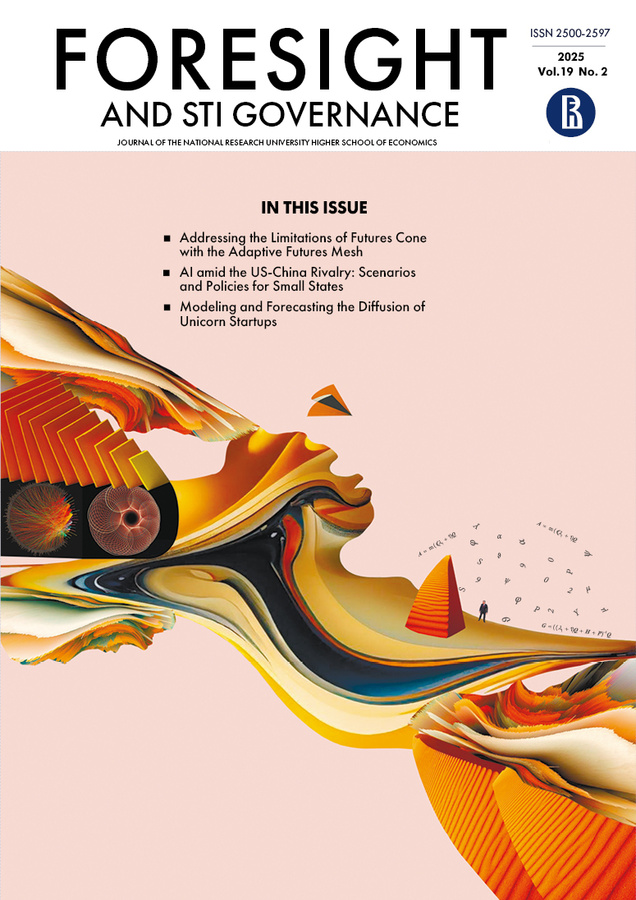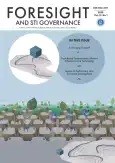IT Governance Enablers
- Authors: Henriques D.1, Pereira R.1, Almeida R.2, Mira da Silva M.2
-
Affiliations:
- Instituto Universitario de Lisboa (ISCTE-IUL)
- Instituto Superior Tecnico - Universidade de Lisboa
- Issue: Vol 14, No 1 (2020)
- Pages: 48-59
- Section: INNOVATION
- URL: https://journal-vniispk.ru/1995-459X/article/view/346993
- DOI: https://doi.org/10.17323/2500-2597.2020.1.48.59
- ID: 346993
Cite item
Abstract
Keywords
About the authors
David Henriques
Instituto Universitario de Lisboa (ISCTE-IUL)
Email: davidrh89@hotmail.com
Av. das Forças Armadas, 1649-026 Lisboa, Portugal
Ruben Pereira
Instituto Universitario de Lisboa (ISCTE-IUL)
Email: ruben.filipe.pereira@iscte.pt
Av. das Forças Armadas, 1649-026 Lisboa, Portugal
Rafael Almeida
Instituto Superior Tecnico - Universidade de Lisboa
Email: rafael.d.almeida@ist.utl.pt
Alameda da Universidade 1649-004 Lisboa, Portugal
Miguel Mira da Silva
Instituto Superior Tecnico - Universidade de Lisboa
Email: mms@ist.utl.pt
Alameda da Universidade 1649-004 Lisboa, Portugal
References
- Ali S., Green P. (2012) Effective information technology (IT) governance mechanisms: An IT outsourcing perspective // Information Systems Frontiers. Vol. 14. № 2. P. 179-193. DOI:https://doi.org/10.1007/s10796-009-9183-y
- Bernroider E.W.N. (2008) IT governance for enterprise resource planning supported by the DeLone-McLean model of information systems success // Information and Management. Vol. 45. № 5. P. 257-269. DOI:https://doi.org/10.1016/j.im.2007.11.004
- Bernroider E.W.N., Ivanov M. (2011) IT project management control and the Control Objectives for IT and related Technology (CobiT) framework // International Journal of Project Management. Vol. 29. № 3. P. 325-336. DOI:https://doi.org/10.1016/j.ijproman.2010.03.002
- Beyer J.M., Nin D.O. (1999) Ethics and cultures in international business // Journal of Management Inquiry. Vol. 8. № 3. P. 287-297. DOI:https://doi.org/10.1177/105649269983006
- Bin-Abbas H., Bakry S.H. (2014) Assessment of IT governance in organizations: A simple integrated approach // Computers in Human Behavior. Vol. 32. P. 261-267. DOI:https://doi.org/10.1016/j.chb.2013.12.019
- Bowen P.L., Cheung M.Y.D., Rohde F.H. (2007) Enhancing IT governance practices: A model and case study of an organization's efforts // International Journal of Accounting Information Systems. Vol. 8. № 3. P. 191-221. DOI:https://doi.org/10.1016/j.accinf.2007.07.002
- Cram W.A., Brohman M.K., Gallupe R.B. (2016) Hitting a moving target: A process model of information systems control change // Information Systems Journal. Vol. 26. № 3. P. 195-226. DOI:https://doi.org/10.1111/isj.12059
- De Haes S., van Grembergen W. (2005) IT Governance Structures, Processes and Relational Mechanisms: Achieving IT/Business Alignment in a Major Belgian Financial Group // Proceedings of the 38th Hawaii International Conference on System Sciences. Waikoloa, HI: IEEE. P. 1-10.
- De Haes S., van Grembergen W. (2008) Analysing the relationship between IT governance and business/IT alignment maturity // Proceedings of the 41th Annual Hawaii International Conference on System Sciences. Waikoloa, HI: IEEE. P. 1-10. DOI:https://doi.org/10.1109/HICSS.2008.66
- Fink K., Ploder C. (2008) Decision support framework for the implementation of IT-governance // Proceedings of the 41th Annual Hawaii International Conference on System Sciences. Waikoloa, HI: IEEE. P. 1-10. DOI:https://doi.org/10.1109/HICSS.2008.113
- Garsoux M. (2013) COBIT5 ISACA's New Framework for IT Governance, Risk, Security and Auditing. An Overview. ISACA Whitepaper 39. Schaumburg, Illinois: ISACA.
- Hardin-Ramanan S., Chang V., Issa T. (2018) A Green Information Technology governance model for large Mauritian companies // Journal of Cleaner Production. № 198. P. 488-497. DOI:https://doi.org/10.1016/j.jclepro.2018.07.047
- Heier H., Borgman H.P., Hofbauer T.H. (2008) Making the most of IT governance software: Understanding implementation processes // Proceedings of the 41th Hawaii International Conference on System Sciences. Waikoloa, HI: IEEE. P. 1-11. DOI:https://doi.org/10.1109/HICSS.2008.239
- Heier H., Borgman H.P., Maistry M.G. (2007) Examining the relationship between IT governance software and business value of IT: Evidence from four case studies // Proceedings of the 40th Annual Hawaii International Conference on System Sciences. Waikoloa, HI: IEEE. P. 1-11. DOI:https://doi.org/10.1109/HICSS.2007.216
- Higgins L., Sinclair D. (2008) A new look at IT governance // Journal of Corporate Accounting & Finance. Vol. 19. № 5. P. 31-36. DOI:https://doi.org/10.1002/jcaf.20415
- Huang R., Zmud R.W., Price R.L. (2010) Influencing the effectiveness of IT governance practices through steering committees and communication policies // European Journal of Information Systems. Vol. 19. № 3. P. 288-302. DOI:https://doi.org/10.1057/ejis.2010.16
- Huygh T., de Haes S., Joshi A., van Grembergen W. (2018) Answering Key Global IT Management Concerns Through IT Governance and Management Processes: A COBIT5 View // Proceedings of the 51st Hawaii International Conference on System Sciences. Vol. 9. Waikoloa, HI: IEEE. P. 5335-5344.
- ISACA (2013) COBIT5: Enabling Information. Schaumburg, Illinois: ISACA.
- ISACA (2018) COBIT2019 Framework: Introduction and Methodology. Schaumburg, Illinois: ISACA.
- Joshi A., Bollen L., Hassink H., de Haes S., van Grembergen W. (2018) Explaining IT governance disclosure through the constructs of IT governance maturity and IT strategic role // Information and Management. Vol. 55. № 3. P. 368-380. DOI:https://doi.org/10.1016/j.im.2017.09.003
- Kerr D.S., Murthy U.S. (2013) The importance of the CobiT framework IT processes for effective internal control over financial reporting in organizations: An international survey // Information and Management. Vol. 50. № 7. P. 590-597. DOI:https://doi.org/10.1016/j.im.2013.07.012
- Kitchenham B. (2004) Procedures for performing systematic reviews. Keele, UK: Keele University.
- Kude T., Lazic M., Heinzl A., Neff A. (2017) Achieving IT-based synergies through regulation-oriented and consensus-oriented IT governance capabilities // Information Systems Journal. Vol. 28. № 2. P. 1-31. DOI:https://doi.org/10.1111/isj.12159
- Lockwood M., Davidson J., Curtis A., Stratford E. (2010) Governance principles for natural resource management // Society and Natural Resources. Vol. 23. № 10. P. 986-1001. DOI:https://doi.org/10.1080/08941920802178214
- Okoli C., Schabram K. (2010) A Guide to Conducting a Systematic Literature Review of Information Systems Research // Sprouts: Working Papers on Information Systems. Vol. 10. № 26. P. 1-51. DOI:https://doi.org/10.2139/ssrn.1954824
- Othman M., Nazir-Ahmad M., Suliman A., Arshad N.H., Maidin S.S. (2014) COBIT principles to govern flood management // International Journal of Disaster Risk Reduction. Vol. 9. P. 212-223. DOI:https://doi.org/10.1016/j.ijdrr.2014.05.012
- Prasad A., Green P., Heales J. (2012) On IT governance structures and their effectiveness in collaborative organizational structures // International Journal of Accounting Information Systems. Vol. 13. № 3. P. 199-220. DOI:https://doi.org/10.1016/j.accinf.2012.06.005
- Queiroz M., Tallon P.P., Sharma R., Coltman T. (2018) The role of IT application orchestration capability in improving agility and performance // Journal of Strategic Information Systems. Vol. 27. № 1. P. 4-21. DOI:https://doi.org/10.1016/j.jsis.2017.10.002
- Selig G.J. (2018) IT Governance - An Integrated Framework and Roadmap for Planning, Deploying & Sustaining for Competitive Advantage. Paper presented at the 2018 PICMET Conference Managing Technological Entrepreneurship: The Engine for Economic Growth, Honolulu, Hawaii, USA.
- Simon J.C., Kaiser K.M., Beath C.M., Goles T. (2007) Information technology workforce skills: Does size matter? // Information Systems Management. Vol. 24. № 4. P. 345-359. DOI:https://doi.org/10.1080/10580530701586102
- Simonsson M., Ekstedt M. (2006) Getting the priorities right: Literature vs practice on IT governance // Proceedings of the 2006 Portland International Conference on Management of Engineering and Technology. Piscataway, NJ: IEEE. P. 18-26. DOI:https://doi.org/10.1109/PICMET.2006.296548
- Simonsson M., Johnson P., Ekstedt M. (2010) The effect of IT governance maturity on IT governance performance // Information Systems Management. Vol. 27. № 1. P. 10-24. DOI:https://doi.org/10.1080/10580530903455106
- Spremic M. (2009) IT Governance Mechanisms in Managing IT Business Value // Corporate Governance. Vol. 6. № 6. P. 906-915.
- Tallon P.P., Ramirez R.V., Short J.E. (2013) The Information Artifact in IT Governance: Toward a Theory of Information Governance // Journal of Management Information Systems. Vol. 30. № 3. P. 141-178. DOI:https://doi.org/10.2753/MIS0742-1222300306
- Tranfield D. (2003) Procedures for performing systematic reviews // British Journal of Management. Vol. 14. P. 207-222. DOI:https://doi.org/10.1111/1467-8551.00375
- Tsoukas H., Vladimirou E. (2001) What is Organizational Knowledge? // Journal of Management Studies. Vol. 38. № 7. P. 973-993. DOI:https://doi.org/10.1111/1467-6486.00268
- Watson R.T., Webster J. (2002) Analysisng The Past to Prepare for The Future: Writing Literature Review // MIS Quarterly. Vol. 26. № 2. P. 13-23.DOI:https://doi.org/10.1.1.104.6570.
- Weill P., Ross J. (2005) A Matrixed Approach to Designing IT Governance // MIT Sloan Management Review. Vol. 46. № 2. P. 26-34. DOI:https://doi.org/10.1177/0275074007310556
- Wu S.P.J., Straub D.W., Liang T.P. (2015) How information technology governance mechanisms and strategic alignment influence organizational performance: Insights from a matched survey of business and IT managers // MIS Quarterly. Vol. 39. № 2. P. 497-518.
Supplementary files









